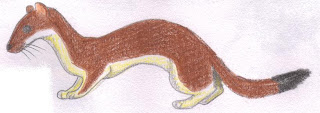
Yaverlandia bitholus Galton, 1971
Family incertae sedis; Saurischia; Sauropsida; Chordata
Not many scientific names begin with 'Y'. This was a difficult letter to do: it took me quite a while, with a bit of help, to find an extant British species, but I got there eventually.
Yaverlandia was described in the '70s from a partial skull, found at Yaverland Point on the Isle of Wight. It was placed within the group of ornithischian ('bird-hipped') dinosaurs known as the pachycephalosaurs. The more derived members of this group, such as Pachycephalosaurus itself, had thickened skulls which may have been used in intraspecific fights, like wild sheep (Ovis spp.) do nowadays. Under this interpretation, Yaverlandia's skull wasn't that thick, but then, being from the early Cretaceous, it predated these derived pachycephalosaurs.
Further study found that Yaverlandia wasn't a basal pachycephalosaur, nor even an ornithischian, but some kind of theropod. Since only an incomplete skull (the back of it) is known, it can't be made more specific than that. To my knowledge, there are no other prehistoric British genera beginning with 'Y', so I had to illustrate Yaverlandia. I went with the reconstruction of it as a pachycephalosaur, as I had nothing else to base it on.

Spindle ermine moth
Yponomeuta cagnagella (Hübner, 1813)
Yponomeutidae; Lepidoptera; Insecta; Arthropoda
The ermine moths are a family of cosmopolitan lepidopterans named after the appearance of some of the species, like Yponomeuta cagnagella, which are white with black spots, remarkably similar to the winter coat of the stoat (Mustela erminea), also known as ermine. This is also reminiscent of the furry borders of royal cloaks, which were traditionally made of ermine, dotted with the black tail-tips of the stoats.
The common name 'spindle' derives from the food plant of the larva, the spindle tree (Euonymus europaeus), a shrub which bears crimson lobed fruit which are toxic to humans. The larvae, like those of many other ermine moths, spin a silken web in which they gather to feed. The larvae themselves are yellow in colour, with similar black spots to the adult moths.

Yellowhammer
Emberiza citrinella Linnaeus, 1758
Emberizidae; Passeriformes; Aves; Chordata
The yellowhammer is a resident passerine found throughout Europe and parts of Asia, having been introduced to New Zealand in 1862. The male is distinctive with his lemon-yellow face and breast marked with rusty brown and black, but he is more well known for his song. It has been interpreted by humans as saying 'a bit of bread and butter with no cheeeeeeese'. In reality, it is a scratchy warble with a long last note, but all the same, it is a very distinctive sound that's always a pleasure to hear in the British countryside in early summer, when the male sings to attract a female.
Yellowhammers are buntings, a group of finch-like birds unique to the Old World. It is similar to other members of the genus, such as the reed bunting (E. schoeniclus) in build, but has brighter coloration, in the males at least.
For the final part next week (next year even!) we have Z: a megalosaur, a bright blue bug and a viviparous lacertid.











+-+oxford+museum+of+natural+history.JPG)

+-+bristol+city+museum.jpg)








+-+apu.JPG)


.jpg)
.JPG)



.JPG)

+-+cambridge+zoology+museum.JPG)

+-+oxford+museum+of+natural+history.JPG)




.jpg)










